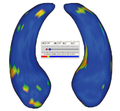Difference between revisions of "2011 Summer Project Week Shape Analysis UNC"
| (12 intermediate revisions by 2 users not shown) | |||
| Line 2: | Line 2: | ||
<gallery> | <gallery> | ||
Image:PW-SLC2011.png|[[2011_Winter_Project_Week#Projects|Projects List]] | Image:PW-SLC2011.png|[[2011_Winter_Project_Week#Projects|Projects List]] | ||
| − | Image: | + | Image:SPHARMPDM_Logo.gif|SOME OUTPUTS: Triangular mesh representation of the input segmentation - The first triangular mesh,mapped in the sphere - Spherical representation of the harmonic representation of the input parameterization - DistanceMap colorMap(after MANCOVA) and Particle |
| − | Image: | + | Image:MANCOVA.jpg|shapeAnalysisMANCOVA -- Pvalues |
| + | Image:shapeAnalysisMANCOVA_Wizard-screenshot.png | shapeAnalysisMANCOVA_Wizard-screenshot | ||
| + | |||
</gallery> | </gallery> | ||
==Key Investigators== | ==Key Investigators== | ||
| − | * UNC: Lucile Bompard, Clement Vachet,Beatriz Paniagua,Martin Styner | + | * UNC: Lucile Bompard, Clement Vachet, Beatriz Paniagua, Martin Styner |
| − | * ...... | + | * Utah: Josh Cates, Manasi Datar, Ross Whitaker |
| + | |||
| + | |||
| + | The UNC shape analysis framework is an automatic shape correspondence methodology that uses spherical harmonics for sampling (SPHARM-PDM). ShapeAnalysisModule computes point-based models using a parametric boundary description. The point-based models computed with this tool are used to perform statistical studies (within shapeAnalysisMANCOVA) or to get correspondence point Models(within ParticleModule). The ParticleModule is already part of the ShapeAnalysisModule. You can choose to run it or not. Nevertheless, some triangulation of spherical harmonics are not preserved, not surprisingly. | ||
<div style="margin: 20px;"> | <div style="margin: 20px;"> | ||
| Line 14: | Line 19: | ||
<h3>Objective</h3> | <h3>Objective</h3> | ||
| − | + | The goal is to improve the Particle Module. We need to set template population that not change their correspondence. That is to say, we have to know how to fix a template for the Particle study. | |
| Line 35: | Line 40: | ||
<h3>Progress</h3> | <h3>Progress</h3> | ||
| + | A template has been set. | ||
| + | We are still testing the improvement of this add on our results. | ||
| Line 47: | Line 54: | ||
#NITRIC distribution | #NITRIC distribution | ||
| − | #Slicer | + | #Slicer Module |
##Built-in | ##Built-in | ||
##Extension -- commandline YES | ##Extension -- commandline YES | ||
##Extension -- loadable YES | ##Extension -- loadable YES | ||
Latest revision as of 21:07, 23 June 2011
Home < 2011 Summer Project Week Shape Analysis UNCKey Investigators
- UNC: Lucile Bompard, Clement Vachet, Beatriz Paniagua, Martin Styner
- Utah: Josh Cates, Manasi Datar, Ross Whitaker
The UNC shape analysis framework is an automatic shape correspondence methodology that uses spherical harmonics for sampling (SPHARM-PDM). ShapeAnalysisModule computes point-based models using a parametric boundary description. The point-based models computed with this tool are used to perform statistical studies (within shapeAnalysisMANCOVA) or to get correspondence point Models(within ParticleModule). The ParticleModule is already part of the ShapeAnalysisModule. You can choose to run it or not. Nevertheless, some triangulation of spherical harmonics are not preserved, not surprisingly.
Objective
The goal is to improve the Particle Module. We need to set template population that not change their correspondence. That is to say, we have to know how to fix a template for the Particle study.
Approach, Plan
Our plan for the project week is to:
- Meet with all interested parties
- Decided how we are going to fix the template
Progress
A template has been set. We are still testing the improvement of this add on our results.
Delivery Mechanism
This work will be delivered to the NAMIC Kit as a
- NITRIC distribution
- Slicer Module
- Built-in
- Extension -- commandline YES
- Extension -- loadable YES



